In engineering and precision manufacturing, accurate measurement is not merely an ideal—it is an operational necessity. Among the various tools developed to meet this demand, the Vernier caliper stands out as a fundamental instrument for acquiring precise linear measurements. Its enduring relevance, despite the rise of digital tools, is a testament to both its simplicity and effectiveness.
Vernier calipers are indispensable in sectors such as mechanical engineering, industrial manufacturing, aerospace, automotive design, and scientific research. Whether in a machine shop, a university lab, or a quality control station, professionals and students alike rely on this instrument for reliable data acquisition.
This guide aims to provide engineers, machinists, students, and quality inspectors with a comprehensive understanding of how to read a Vernier caliper accurately. From its historical development to the intricacies of its scale system, we’ll break down each aspect to demystify its usage and reinforce confidence in its application.
A Brief History of Vernier Calipers
Origin of the Vernier Scale
The concept of the Vernier scale was introduced by French mathematician Pierre Vernier in 1631. His invention addressed the limitations of traditional linear measurement methods by enabling users to interpolate readings between the smallest divisions on a scale. This innovation allowed for the accurate detection of minute differences, revolutionizing scientific measurement.

Development of Calipers
The earliest calipers were simple, compass-style devices used to compare lengths and transfer dimensions. Over time, these evolved into sliding calipers that could measure both internal and external dimensions. The integration of Vernier’s scale transformed these tools into high-precision instruments capable of readings as fine as 0.02 mm or 0.001 inch, depending on the model.
Modern Usage
Today, Vernier calipers come in analog and digital forms, each serving distinct roles across industries. While digital calipers offer convenience and rapid readings, analog Vernier calipers remain essential for environments requiring durability, independence from batteries, and a deeper understanding of mechanical measurement fundamentals.
Anatomy of a Vernier Caliper
To master the use of a Vernier caliper, one must first understand its components and their functions:
Main Scale
The main scale resembles a traditional ruler and is typically marked in either millimeters or inches. It provides the base measurement and is etched into the caliper’s fixed body.
Vernier Scale
The Vernier scale is a secondary sliding scale that runs parallel to the main scale. It allows the user to read fractional parts of the smallest main scale division, enhancing the resolution of the instrument. The number of divisions on the Vernier scale is carefully designed to provide this increased precision, commonly to the nearest 0.02 mm or 0.001 inch.
Fixed Jaw
This component is stationary and attached to the main scale. It serves as the reference point from which all measurements are taken.
Sliding Jaw
The sliding jaw moves along the main scale and contains the Vernier scale. It opens or closes to encompass the object being measured, whether it’s an external diameter, internal width, or depth.
Depth Rod
The depth rod extends from the end of the caliper as the sliding jaw moves. It is used to measure the depth of holes, slots, or recesses accurately—an essential feature in engineering designs where multi-dimensional accuracy is required.
Locking Screw
Once the desired measurement is set, the locking screw can be tightened to hold the position of the sliding jaw. This is particularly useful for transferring dimensions or recording consistent measurements during quality control.
Thumb Wheel
Located near the sliding jaw, the thumb wheel allows for smooth and controlled movement along the scale. This facilitates fine adjustments and ensures that pressure applied during measurement remains consistent.
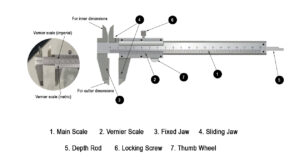
How to Use a Vernier Caliper
Vernier calipers are versatile instruments capable of measuring multiple dimensions with high precision. Understanding the correct usage for each measurement type is critical to ensure reliability and repeatability in engineering applications.
External Measurements
To measure the external dimensions—such as the outer diameter of a shaft or the width of a block—use the outside jaws of the caliper:
Open the jaws and place them around the object.
Gently close the jaws until they make contact with the surfaces.
Use the thumb wheel to fine-tune the position without applying excessive force.
Tighten the locking screw to secure the measurement before reading.
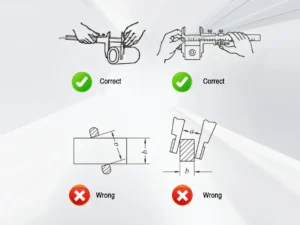
Internal Measurements
To measure internal dimensions—such as the diameter of a hole—use the inside jaws:
Insert the inside jaws into the feature to be measured.
Expand the jaws until they contact the internal surfaces.
Ensure the caliper is perpendicular to the axis of the hole for an accurate reading.
Lock the jaws in place before taking the measurement.
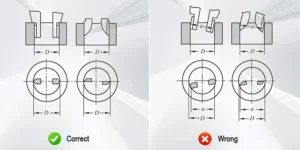
Depth Measurements
The depth rod is used for determining the depth of blind holes, recesses, or cavities:
Extend the depth rod by moving the sliding jaw backward.
Insert the end of the caliper flat against the reference surface.
Continue sliding until the rod touches the bottom of the feature.
Lock the position and record the reading.
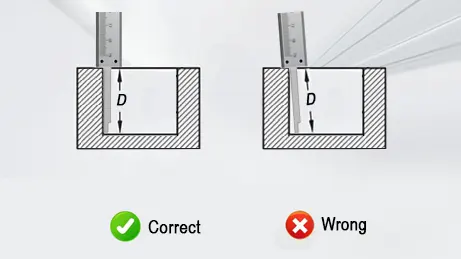
Step Measurements
Step dimensions—such as the offset between two surfaces—are measured using the step-measuring faces on the back of the caliper:
Position the fixed jaw against the upper surface.
Lower the sliding jaw onto the lower step.
Lock and read the scale to obtain the vertical difference.
Marking with Calipers
While not primarily a layout tool, calipers can assist in precision marking.
Scraping Method: Use the fixed and sliding jaws to lightly scribe a line on a metal surface.
Pencil Method: For less abrasive marking, a pencil or fine-tip marker can be run along the edge of the jaw.
Use caution when marking, especially on finished parts, to avoid surface damage.
How to Read a Vernier Caliper
Correctly reading a Vernier caliper involves a systematic approach. Whether using metric or imperial units, follow this step-by-step procedure to ensure accuracy:
Step 1: Calibrate the Zero
Close the jaws fully and check if the zero on the Vernier scale aligns with the zero on the main scale.
If the zeros do not align, note the zero error. This must be accounted for during measurement (positive or negative).
Calibration should be checked regularly to maintain measurement integrity.

Step 2: Position the Object
Open the caliper and place the object between the appropriate jaws or under the depth rod.
Ensure proper orientation and consistent pressure.
Once in position, tighten the locking screw to secure the reading.
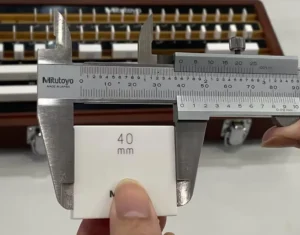
Step 3: Read the Main Scale
Observe the main scale just before the zero mark on the Vernier scale.
Record this value. It represents the main measurement in millimeters or inches, depending on the scale type.
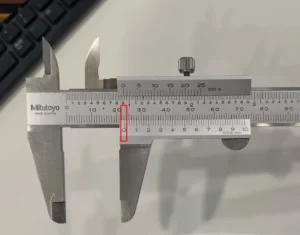
Step 4: Read the Vernier Scale
Look along the Vernier scale for the line that aligns exactly with any line on the main scale.
Identify the number of this line on the Vernier scale.
Multiply this number by the least count of the caliper (commonly 0.02 mm or 0.001 in).
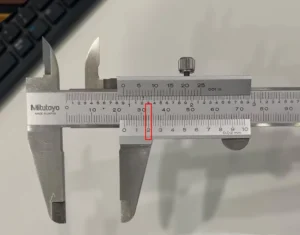
Step 5: Add Both Readings
Use the formula:
Final Measurement = Main Scale Reading + (Vernier Scale Alignment × Least Count)
Example (Metric Caliper with 0.02 mm Least Count):
Main scale reading = 24.00 mm
Vernier scale alignment = 7th division
Final measurement = 24.00 + (7 × 0.02) = 24.14 mm
This technique ensures precision up to two decimal places, crucial for tight-tolerance engineering work.
The Formula for Reading Vernier Calipers
Understanding the formula behind Vernier caliper readings is crucial for accurate interpretation of measurements. The calculation combines values from both the main scale and the Vernier scale.
Standard Formula:
Total Reading=Main Scale Reading+ (Vernier Scale Alignment×Least Count)
Main Scale Reading: The value on the fixed scale just before the Vernier scale zero.
Vernier Scale Alignment: The index or tick mark on the Vernier scale that aligns precisely with a tick on the main scale.
Least Count (LC): The smallest measurable increment on the caliper.
Understanding the Alignment Index
The alignment index is determined by identifying the mark on the Vernier scale that best aligns with any mark on the main scale. For instance:
If the 7th tick on the Vernier scale aligns with a mark on the main scale, and the least count is 0.01 mm:
Vernier Contribution=7×0.01=0.07 mm
This value is added to the main scale reading to give the total measurement.
Examples:
Metric Example
Main scale reading: 13.00 mm
6th tick on Vernier aligns with the main scale
Least Count (LC): 0.02 mm
Total=13.00 mm+(6×0.02)=13.12 mm
Imperial Example
Main scale reading: 1.200 in
3rd tick on Vernier aligns
Least Count: 0.001 in
Total=1.200 in+(3×0.001)=1.203 in
The formula remains the same across metric and imperial systems; only the units and least count vary depending on the scale configuration.
What Is Least Count?
Definition:
The least count of an instrument is the smallest value it can measure with accuracy. In the case of Vernier calipers, it represents the difference between one main scale division and one Vernier scale division.
Formula:
Least Count = Smallest Main Scale Division/Number of Vernier Divisions
This formula arises from the differential measurement principle—where the Vernier scale interpolates values smaller than what the main scale can resolve.
Examples:
Metric Vernier Caliper
Smallest main scale division: 1 mm
Vernier scale divisions: 10
Least Count=1/10=0.1 mm
Some higher-precision calipers may have 50 divisions:
Least Count=1/50=0.02 mm
Imperial Vernier Caliper
Smallest main scale division: 0.1 in
Vernier scale divisions: 10
Least Count=0.1/10=0.01 in
Importance in High-Precision Measurements
Least count determines the resolution of the caliper. A smaller least count allows finer measurement discrimination, which is vital in applications like:
Tolerance inspection in precision machining
Quality control in aerospace component fabrication
Research involving material deformation or thermal expansion
An engineer must always know the least count of the instrument being used, as it dictates both the accuracy of readings and the level of confidence in critical measurements.
Compensating for Zero Error
Even a high-quality Vernier caliper can develop zero error over time due to wear, debris, or improper handling. Failing to account for this can systematically offset all your measurements.
Types of Zero Error
Positive Zero Error
Occurs when the Vernier zero lies to the right of the main scale zero when the jaws are fully closed.
This means the caliper is “reading too much,” so the zero error must be subtracted from the measured value.
Negative Zero Error
Happens when the Vernier zero is to the left of the main scale zero.
The caliper is “reading too little,” so the zero error must be added to the measurement.
Formula for Compensation
Correct Reading=Measured Value−Zero Error
Where the sign of the zero error is positive or negative depending on its direction.
Worked Example (Zero Error Correction)
Suppose you’re measuring a component and obtain a measured value of 25.16 mm. However, when you close the jaws fully, the Vernier zero aligns at 0.04 mm to the right of the main scale zero.
This indicates a positive zero error of +0.04 mm.
Apply the correction:
Correct Reading=25.16 mm−0.04 mm=25.12 mm
If, instead, the Vernier zero was to the left by 0.02 mm, the error would be −0.02 mm, and the corrected value would be:
25.16 mm−(−0.02 mm)=25.18 mm
Always check for zero error before measurements, especially in precision applications.
Common Mistakes When Reading Vernier Calipers
Even experienced professionals can make errors when using Vernier calipers. Awareness of these common pitfalls enhances measurement accuracy and reliability.
1. Zero Error Ignorance
Mistake: Taking measurements without checking for zero error.
Impact: Results in a consistent offset in all readings.
Solution: Always verify zero alignment before use and apply the appropriate correction.
2. Parallax Error
Mistake: Reading the scale from an angle instead of directly above.
Impact: Misinterpretation of the alignment between scale marks.
Solution: Align your eye perpendicularly to the scales during measurement.
3. Scale Misalignment
Mistake: Not ensuring the jaws are square to the object.
Impact: Leads to incorrect readings, particularly in round or irregular shapes.
Solution: Use even pressure and check jaw alignment visually before locking the caliper.
4. Reading the Wrong Scale
Mistake: Confusing metric and imperial scales, especially on dual-scale calipers.
Impact: Major discrepancies in recorded values.
Solution: Clearly identify and consistently use one unit system throughout the task.
5. Improper Use of Jaws
Mistake: Using external jaws for internal measurements or vice versa.
Impact: Inaccurate results due to tool geometry not matching the application.
Solution: Understand the purpose of each jaw set and apply accordingly:
Outside jaws for external measurements.
Inside jaws for internal dimensions.
Depth rod for depth.
Step feature for offset or step dimensions.
Avoiding these common mistakes ensures precise, repeatable measurements—essential in engineering, manufacturing, and quality assurance environments.
Operating Environment and Usage Range
While Vernier calipers are precision tools, their accuracy is sensitive to environmental factors and handling practices. Proper usage conditions ensure consistent performance and prolong tool life.
Working Temperature Range
Ideal operating range: 5°C to 40°C (41°F to 104°F)
Thermal expansion of the metal can distort readings if the caliper or the object being measured is too hot or cold.
Best practice: Allow calipers and parts to acclimate to room temperature before measurement.
Humidity
High humidity or exposure to moisture can lead to corrosion, especially in carbon steel or non-stainless calipers.
Storage: Keep calipers dry, ideally in a protective case with silica gel packets to absorb moisture.
Cleanliness
Dust, oil, or metal shavings on the jaws or scale can skew readings.
Before use: Wipe the jaws with a soft cloth and check the scale for debris.
Avoid applying too much cutting fluid or grease near the measuring surfaces.
Handling Tips
Avoid dropping the caliper—shock can displace the scale or affect alignment.
Don’t overtighten the locking screw, which may lead to internal stress or warping.
Recalibrate periodically, especially in industrial environments or after impact.
Practice Problems & Worked Examples
To reinforce the reading method, here are five common scenarios with solutions:
Example 1: Basic External Diameter
Object: Shaft
Main scale reading: 36.0 mm
Vernier alignment: 4th division
Least Count: 0.02 mm
Reading=36.0+(4×0.02)=36.08 mm
Example 2: Internal Groove Width
Object: Retaining ring groove
Main scale reading: 15.0 mm
Vernier alignment: 9th tick
Least Count: 0.02 mm
15.0+(9×0.02)=15.18 mm
Example 3: Positive Zero Error Adjustment
Measured reading: 42.10 mm
Zero error: +0.04 mm
42.10−0.04=42.06 mm42.10 – 0.04 = \textbf{42.06 mm}42.10−0.04=42.06 mm
Example 4: Complex Scenario with 9th Tick
Main scale: 28.0 mm
Vernier alignment: 9
LC: 0.01 mm
28.0+(9×0.01)=28.09 mm
Example 5: Depth Measurement
Object: Blind hole
Main scale: 12.0 mm
Vernier alignment: 5
LC: 0.02 mm
12.0+(5×0.02)=12.10 mm
Practice with physical parts and verified dimensions is highly recommended to build muscle memory and confidence.
Conclusion: Reading Vernier Calipers – A Wrap-Up
Reading a Vernier caliper is a core skill for every engineer, technician, or quality inspector. Mastery lies in understanding its structure, principles, and correct application.
Summary Checklist
Identify and understand each component (main scale, Vernier scale, jaws, depth rod).
Read the main scale and Vernier alignment systematically.
Use the reading formula and account for the least count.
Always correct for any zero error.
Practice regularly to develop confidence and precision.
Final Note
While the concept may initially seem mechanical, true proficiency comes with repetition, reflection, and awareness. With consistent hands-on experience, the Vernier caliper becomes not just a tool but an extension of the engineer’s eye for precision.


Pingback: CNC Turning-milling Compound and CNC Machining Differences - All about cnc in our site, we provide profesional knowledge at this fields.